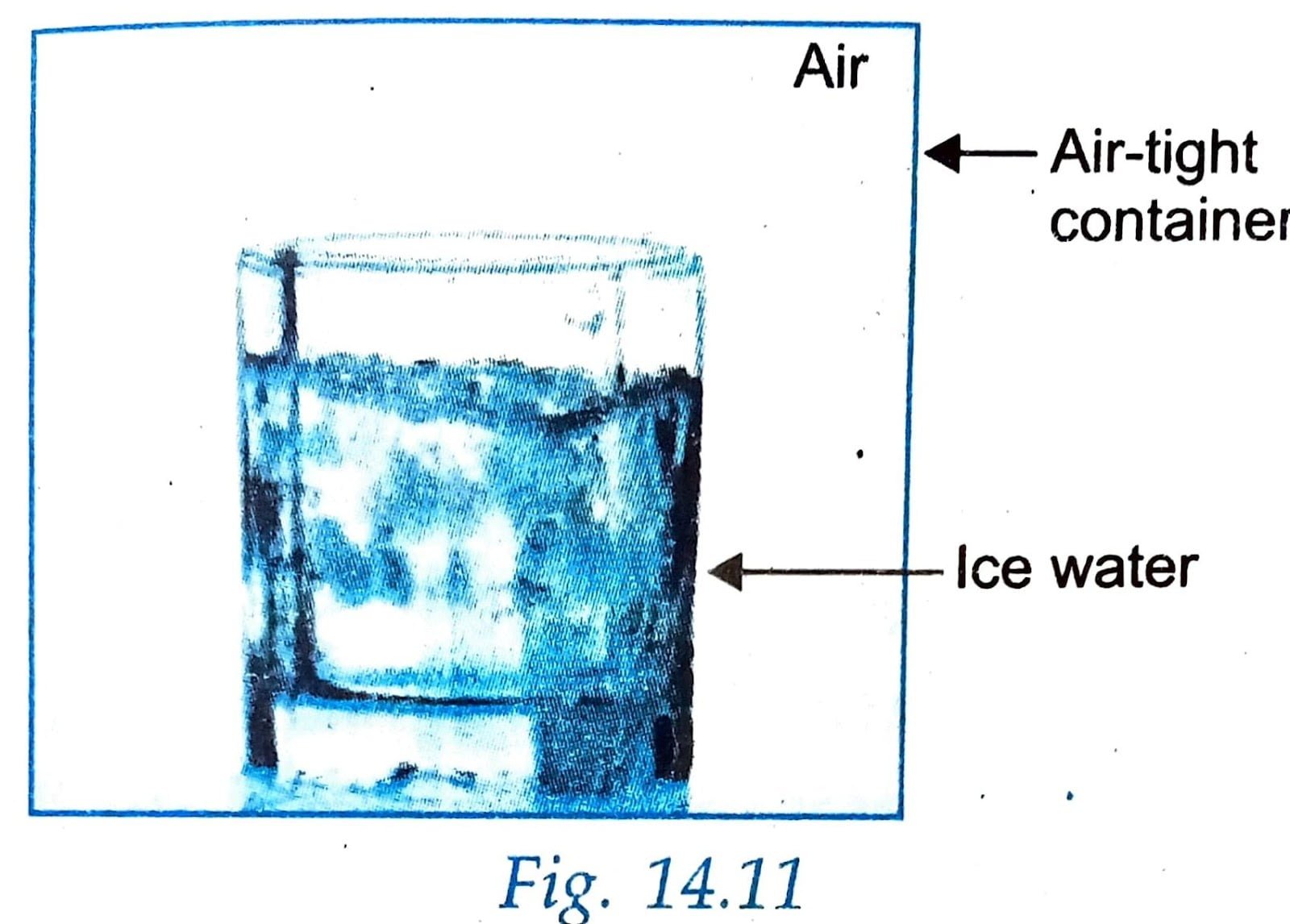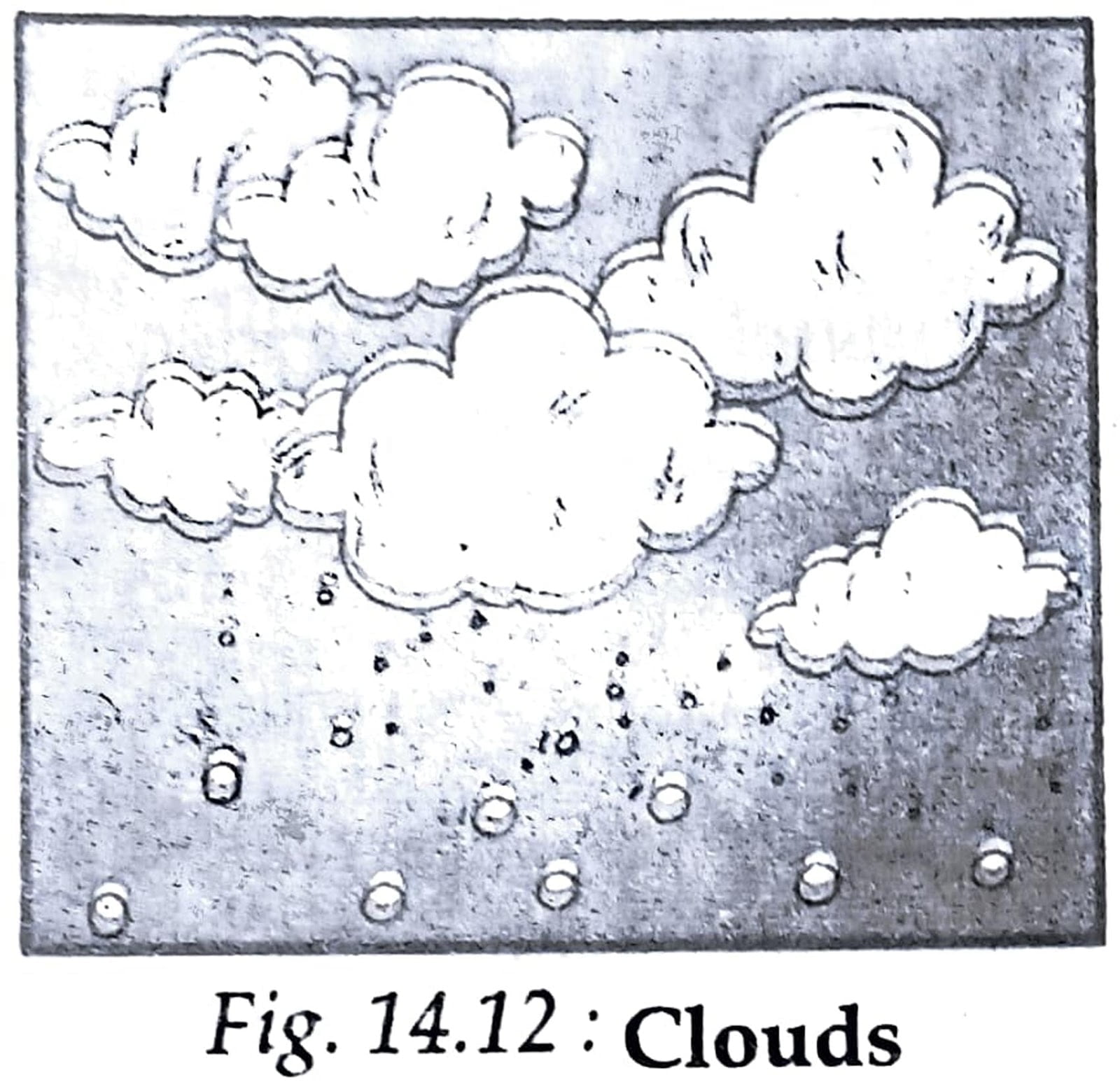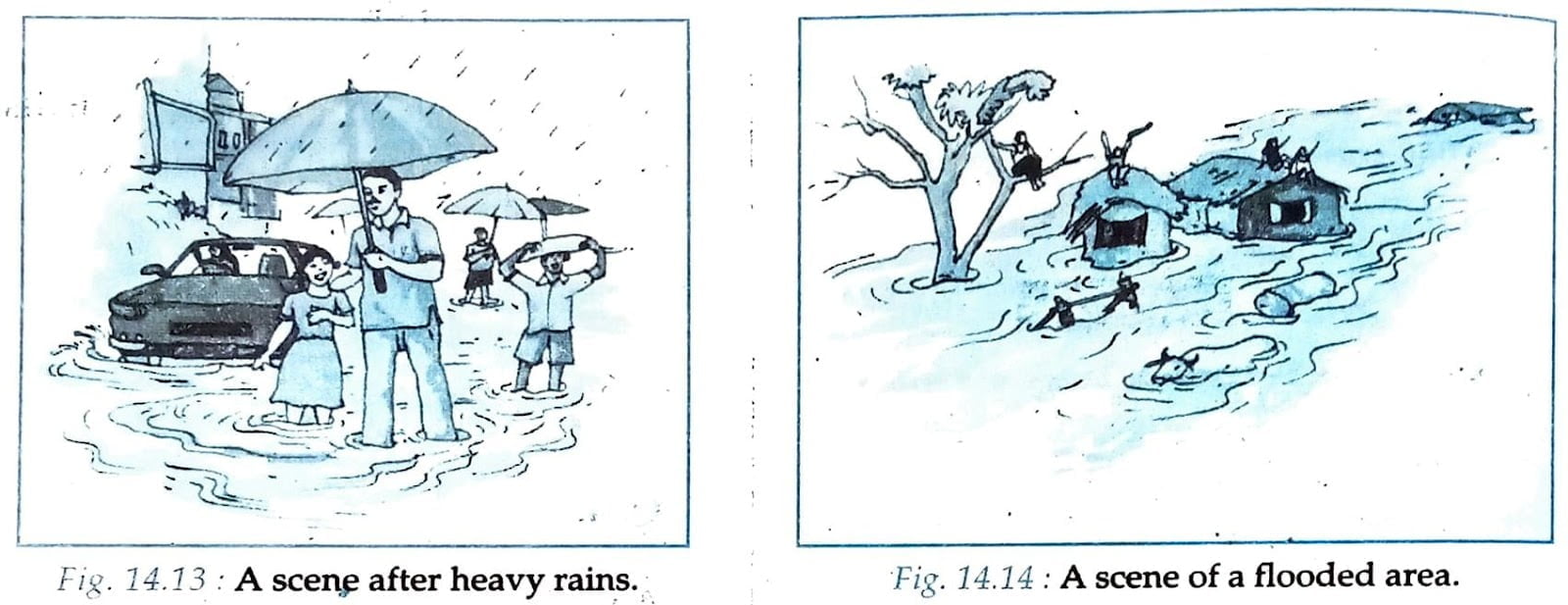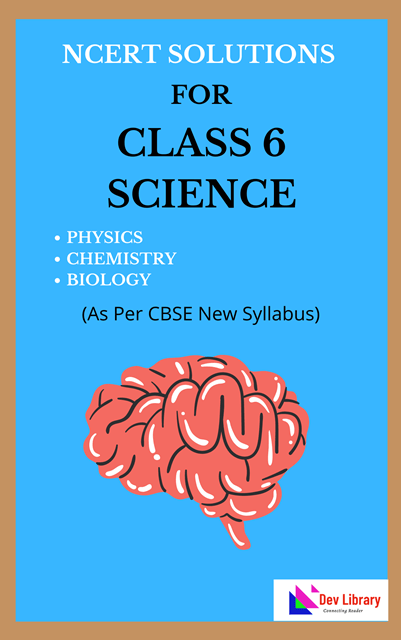NCERT Class 6 Science Chapter 14 Water Solutions to each chapter is provided in the list so that you can easily browse through different chapters NCERT Class 6 Science Chapter 14 Water and select need one. NCERT Class 6 Science Chapter 14 Water Question Answers Download PDF. NCERT Class 6 Science Solutions.
NCERT Class 6 Science Chapter 14 Water
Also, you can read the NCERT book online in these sections Solutions by Expert Teachers as per Central Board of Secondary Education (CBSE) Book guidelines. CBSE Class 6 Science Solutions are part of All Subject Solutions. Here we have given NCERT Class 6 Science Chapter 14 Water and Textbook for All Chapters, You can practice these here.
Water
Chapter: 14
NCERT TEXT BOOK EXERCISES
Q. 1. Fill up the blanks in the following:
(a) The process of changing of water into its vapour is called _________.
Ans: Evaporation.
(b) The process of changing water vapour into water is called __________.
Ans: Condensation.
(c) No rainfall for a year or more may lead to ________ in that region.
Ans: Drought.
(d) Excessive rain may cause ___________.
Ans: Flood.
Q. 2. State for each of the following whether it is due to evaporation or condensation.
(a) Water drops appear on the outer surface of a glass containing cold water.
Ans: Condensation
(b) Steam rising from wet clothes while they are ironed.
Ans: Evaporation.
(c) Fog appearing on a cold winter morning.
Ans: Condensation.
(d) Black board dries up after wiping it.
Ans: Evaporation.
(e) Steam rising from a hot girdle when water is sprinkled on it.
Ans: Evaporation.
Q.3. Which of the following statements are “true”?
(a) Water vapour is present in air only during the monsoon.
Ans: False.
(b) Water evaporates into air from oceans, rivers and lakes but not from the soil.
Ans: False.
(c) The process of water changing into its vapours, is called evaporation.
Ans: True.
(d) The evaporation of water takes place only in sunlight.
Ans: True.
(e) Water vapour condenses to form tiny droplets of water in the upper layers of air where it is cooler.
Ans: True.
Q. 4. Suppose you want to dry your school uniform quickly. Would spreading it near an anghiti or heater help? If yes, how?
Ans: Yes, if we want to dry our school uniform quickly, we should spread our clothes near a anghiti or heater. Because near anghiti or heater, temperature is more, which helps water evaporation from the clothes and they dry quickly.
Q. 5. Take out a cooled bottle of water from refrigerator and keep it on a table. After some time you notice a puddle of water around it. Why?
Ans: When we keep a bottle of water taking out from refrigerator we notice some puddles of water around it. This is because the water-vapour near the surrounding atmosphere, condenses and deposits around the cooled water bottle. Water vapour always remains in the atmosphere.
Q. 6. To clean their spectacles, people often breathe out on glasses to make them wet. Explain why the glasses becomes wet?
Ans: When we breathe on the spectacles, water comes out from our breathe and they condenses into water droplets when they come in contact of glass, because the glasses are cooler than the water vapours. So the glass become wet, due to water puddles.
Q. 7. How are clouds formed?
Ans: The water vapours that goes into air rises up along with air. As the air moves up, it gets cooler and cooler. At sufficient

heights, air becomes so cool that the water vapour present in it condenses to form tiny drops of water called droplets. These droplets are very small, much smaller than even a grain of sand. These droplets are so small that lakhs of them together would form a drop of water.
These tiny droplets remain suspended in the air and moves along with it. When these water droplets in the air come closer they may combine to form slightly bigger droplets. In this way their sizes may become larger. Once the size of the droplets become larger than a definite size, they appear to us as clouds.
Q. 8. When does a drought occur?
Ans: If it does not rain in a region for a year or more. The soil continues to lose water by evaporation and transpiration. Since it is not being brought back by rain, the soil becomes dry. The water level of water in ponds and wells of the region goes down and some of them may even dry up. The ground water may also become scarce. This may lead to drought.
SOME OTHER IMPORTANT QUESTIONS FOR EXAMINATION
VERY SHORT ANSWER QUESTIONS
Q. 1. What name is given to the activity in which rain water is made to percolate into the ground effectively?
Ans: Rainwater harvesting
Q. 2. From where do lakes, ponds and wells get their water?
Ans: Rains.
Q.3. Name two processes which transfer water present on the earth into water vapour continuously.
Ans: Evaporation and Transporation.
Q. 4. In which forms, water exists on the Earth?
Ans: Water exists on the earth in solid (ice), liquid (water) and gaseous (vapour) forms.
Q. 5. Why is ocean water not suitable for domestic use?
Ans: The ocean water is not suitable for domestic use due to the various salts dissolved in it.
Q. 6. Name a process other than evaporation through which water gets transferred into air as water vapour.
Ans: Transpiration.
Q. 7. Name (a) solid state of water and (b) gaseous state of water.
Ans: (a) Ice (or snow) (b) Water vapour (for steam).
Q. 8. Name the process which is involved in the formation of (a) dew and (b) fog.
Ans: (a) Condensation.
(b) condensation.
Q. 9. What name is given to the conditions of extreme dryness in an area due to lack of rain for a long period?
Ans: Drought.
Q. 10. How are the clouds formed?
Ans: Clouds are formed by the condensation of water vapour at high altitude.
Q. 11. What is transpiration?
Ans: Loss of water in the form of water vapour through stomata of leaves is called transpiration.
Q. 12. In which forms, water exists on the earth?
Ans: Water exists on the earth in all three physical forms: ice, water and water vapour.
Q. 13. Write the sources of water on the earth.
Ans: Sources of water on the earth are: seas, oceans, rivers, springs, tubewells, etc.
Q. 14. What is meant by conservation of water?
Ans: Careful, economical and wise use of water and avoiding the wastage of water is called conservation of water.
Q. 15. Why is water in the oceans and seas saline?
Ans: The water in the oceans and seas has many salts dissolved in it. That is reasons that water in the oceans and seas is saline.
Q. 16. How does water vapour enter the air?
Ans: Water vapour enters the air through the processes of evaporation and transpiration by plants.
Q. 17. What are the different forms in which the water in the air comes back to the earth?
Ans: The water in the air comes back to the earth in the form of rain, hail and snow.
Q. 18. How are streams and rivers formed?
Ans: Snow on the mountain melts in water. This water flows down the mountains in the form of streams and rivers.
Q. 19. What happens when there is no rain for one or two years in any region?
Ans: If is no rain in any region for two or more than two years, it results into drought.
Q. 20. What will be the result of drought?
Ans: As a result of drought, there will be no crop and food and fodder will decrease.
Q. 21. What will happen if there is a continuous rain?
Ans: It results into floods.
Q. 22. What process can be used for desalination of sea water?
Ans: Reverse osmosis.
Q. 23. Name the most common practice of recharging ground water.
Ans: Rain-water harvesting.
Q. 24. What is the percentage of water that is available for use?
Ans: Only a tiny fraction about 0.01% of total water is used by human being.
Q. 25. Write two uses of water in plants.
Ans: (i) They use water in photo- synthesis.
(i) Water is essential for germination of seeds.
SHORT ANSWER QUESTIONS
Q. 1. Look at the following diagram in which a potted plant is enclosed in an airtight, transparent plastic bag.

(a) What collects inside the plastic bag after some time?
Ans: Water drops collect inside the plastic bag after some time.
(b) What does this activity show?
Ans: This activity shows that plants give out water vapour through the leaves.
Q. 2. How are clouds formed?
Ans: Water vapours being l. At the upper layer, they are condensed into tiny water droplets and form clouds. These clouds while falling down cause rains.
Q. 3. Give two main functions of water for living organisms.
Ans: Two main functions of water for living organisms are:
(i) Water is essential for the germination of seeds, growth of plants and in photosynth
Q.4. Why do aquatic animals survive in severe winter in cold countries?
Ans: In severe winter when water freezes, a thick layer of ice is formed on its water floats on its surface and the water below this is left unfree.
Q. 5. During summer, fish in shallow ponds die. Why?
Ans: The water in the ponds become hot ases and fish do not get sufficient oxygen for their survival Due to lack of oxygen, the fish died.
Q. 6. We should use ground water judiciously. Why?
Ans: If large quantity of ground water is take out for various purposes, the water level goes down. Thus there will be shortage of water and it is not possible if we continuously use this water. So we should use ground water very carefully.
Q. 7. A material P can exist in three physical states: solid, liquid and gaseous, No living thing on earth can exist in the absence of this material. The material falls from the clouds in the form of Q. Lack of Q for long periods in an area may cause R whereas excess of Q may cause S.
(a) What are (i) P (ii) Q (iii) R and (iv) S?
Ans: (i) Water.
(ii) Rain.
(iii) Drought.
(iv) Floods.
(b) What is the solid state of P known as?
Ans: (b) Ice (or snow).
Q. 8. How are lakes and ponds formed?
Ans: Lakes and ponds are small reservoirs of water. These are created by collection of rain water in low lying areas Seepage from the ground water reservoirs also adds to the water in lakes and ponds.
Q. 9. A glass of ice water is put in an air-tight container as shown below:

(a) After a short while, state whether the air in the container will contain less water vapour or more water vapour?
Ans: The air in the container will contain less water vapour.
(b) Give reason for your answer.
Ans: After a short while, some of the water of air condenses to form drops of water on the sides of glass of ice water (leaving less-water vapour in the air).
Q. 10. Why is ocean water not suitable for domestic use?
Ans: Sea and ocean water contains large amounts of various salts. It is due to these salts the ocean water is salty and cannot be used for drinking, washing and for irrigation purposes.
Q. 11. What are the causes of floods?
Ans: (i) Heavy continuous rains.
(ii) Cyclones which bring heavy rain.
(iii) Landslides which may block the rivers.
(iv) Tidal waves, like a tsunami.
Q. 12. Write two differences between condensation and evaporation.
Ans:
| Condensation | Evaporation |
| 1. It is a process of conversion of water vapours to water drops. | 1. It is a process of conversion of water to water vapours. |
| 2. Condensation takes place as very low temperature. | 2. Evaporation takes place even at room temperature. |
Q. 13. Explain fog formation.
Ans: During winter, sometimes, condensation of water vapours starts near the surface of earth. These clouds of condensed vapour do not become water drops and do not rain. In fact these appear near the earth surface as fog.
Q. 14. How rainfall occurs?
Ans: When clouds huddle together, they get bigger and heavier. The small droplets in them come together to form big drops. The clouds, now no more remain suspended up in the air. They begin to drift down faster. When they come closer to earth, the big drops dripping down as rain water. This is rainfall.
SHORT ANSWER QUESTIONS
Q. 1. How does water cycle help in maintaining global climate?
Ans: Water cycle plays an important role in the world climate. Oceans absorb vast quantities of heat and help in global warming. By absorbing heat, water evaporates and on condensation releases heat. This absorption and releasing of heat in the form of energy drives weather pattern in the short-term and regulate the climate for long time.
Q. 2. How does rain water become saline?
Ans: Water is a universal solvent, because it dissolves a large number of substances. When rain falls, it dissolves common salts and many other substances and minerals present on the earth. The rain water passes through different layers of earth, rocks, dissolves large amount of salt and other minerals. Thus it becomes salty.
Q. 3. How will you show the presence of water in air?
Ans: Take some pieces of ice in a beaker and keep it for some time. After some time, we will observe that small water drops are formed on the cold outer surface wall of the beaker. These water drops are formed by the condensation of those water vapours which were present in air around beaker. This shows that water is present in air.
Q. 4. Write three effects of drought on soil.
Ans: (i) Soil becomes too dry to be ploughed for growing crops.
(ii) Useful microbes in the soil are killed.
(iii) It becomes barren for cultivation.
Q. 5. How does heavy rain affect us?
Ans: Heavy rains may cause:
(i) A rise of water level in dams, rivers, lakes, etc.
(ii) Water logging and floods.
(iii) Floods cause damage to property,crops and animals.
Q. 6. How does the failure of rainfall affect people on the earth?
Ans: The failure of rainfall can cause the following:
(i) The soil becomes dry.
(ii) Water level in rivers, lakes, dams, etc.may fall. Ponds and canals even dry up.
(iii) The ground water level falls.
Q. 7. Write any three suggestions for conserving water.
Ans: Suggestions for conserving water:
(i) Use only the required quantity of water.
(ii) Trees and forests help in causing rain fall. So to conserve water, we should plant more and more trees.
(iii) By collecting rain water in tanks, ponds or by constructing check dams.
Q.8. Write three effects of flood on soil.
Ans: (i) Soil remains covered with water.
(ii) Top fertile soil gets eroded.
(iii) Crops get destroyed due to water logging.
Q.9. The process of condensation plays an important role in bringing water back to the surface of earth. Explain.
Ans: As we go higher from the surface of the earth, it gets cooler. When the air moves up, it gets cooler and cooler. At sufficient heights, the air becomes so cool that the water vapour present in it condenses to form tiny drops of water called droplets. It is these tiny droplets that remain floating in air and appear to us as clouds.
It so happens that many droplets of water come together to form larger sized from the fields, roads, rooftops and other land areas.
Q. 10. How does water in the atmosphere/air return to the earth?
Ans: The water in the atmosphere/air returns to the earth in the form of
(i) rain.
(ii) hail. or
(iii) snow.
(i) When the small droplets in clouds come together to form bigger drops of water, they become heavy and fall down as rain.
(ii) If the temperature falls, the rain drops get frozen and fall down as hails.
(iii) If the temperature falls further, these droplets/drops, get frozen and fall down as snow.
Higher Order Thinking Skill Questions
Q. 1. Give two advantages of rain-water harvesting.
Ans: (i) Rainwater harvesting in rural areas increases agricultural production and hence the income of farmers.
(ii) Rainwater harvesting reduces the effect of floods and increases the life of dams in the downstream area.
Q. 2. What is the consumption of water
(i) in a village.
Ans: (i) Per person consumption of water in a village in our country is about 12 litres per day.
(ii) in a city in our country per person per day?
Ans: Per person consumption of water in a city is between 50-200 litres per day.
Q. 3. How does water from the earth’s surface escape into the atmosphere?
Ans: Water from the earth’s surface) continues to evaporate due to heat of the sun. Thus water from the earth’s surface escapes into the atmosphere in the form of water vapours.
Q. 4. Why does the water spilt on the floor disappear after some time?
Ans: Water from the floor absorbs heat from the surroundings and gets converted into vapour. The water vapour escapes into the atmosphere. Thus, water spilt on the floor disappears after some time.
Q. 5. Water bill shows the consumption of water to be 1500 gallons for one month. Calculate the amount of water used by your family
(i) in one day. and
(ii) in one year.
Ans: Water used in one month = 1500 gallons (given)
Water used in one day = 1500/30 = 50 gallons
Water used in one year = 1500 x 12 = 18,000 gallons.
Skill Based Questions
Q. 1. Draw a diagram to show the clouds in nature.
Ans:

Q. 2. Draw a diagram to show:
(i) A scene after heavy rains.
Ans: A scene after heavy rain.
(ii) A scene of a flooded area.
Ans: A scene of a flooded area.

FORMATIVE ASSESSMENT
Q. 1. Fill in the following blanks with suitable words:
(i) More than ____________ of the earth’s surface is covered with water.
Ans: Two thirds.
(ii) Water can be changed from one state to another by __________ Or ___________.
Ans: Heating, cooling.
(iii) The amount of usable water is limited, so we should take care not to __________water.
Ans: Waste.
(iv) The continuous movement of water from the earth to atmosphere and back to the earth is called ___________.
Ans: Water cycle.
(v) The process by which rain water changes into snow is called ___________.
Ans: Freezing.
(vi) The loss of water from the leaves of plants as water vapour through the stomata is called _____________.
Ans: Transportation.
(vii) The highly salty water of an ocean is converted into pure water in nature by ____________.
Ans: Water cycle.
(viii) Lack of rain causes ______________.
Ans: Drought.
(ix) The circulation of water between ocean and land is known as _______________.
Ans: Water cycle.
(x) ____________ is a source for many lakes and hand pumps.
Ans: Ground water.
Q. 2: State whether the following statements are true or false:
(i) Sea-water can be used for the irrigation of crops like wheat.
Ans: False.
(ii) It is the ocean water which ultimately reaches rivers, lakes, ponds and wells which supply us water.
Ans: Ture.
(iii) Water can also exist as a solid or gas.
Ans: True.
(iv) Sea water is saline.
Ans: True.
(v) Sunlight is essential to convert water into its vapour.
Ans: False.
(vi) In nature, water exists as only liquid water.
Ans: False.
(vii) Humans and animals release water vapour into the air by the phenomenon called transpiration.
Ans: False.
(viii) Water cycle helps in regulating weather on the earth.
Ans: True.
(ix) Below 0°C, water exists in the liquid state.
Ans: False.
(x) Above 100°C, water exists in the gaseous state as steam (water vapour).
Ans: True.
Q. 3. Match the items given in Column A with those in Column B:
| Column A | Column B |
| 1. Rain water | (a) Hand pump |
| 2. Water cycle | (b) Winter morning |
| 3. Ground water | (c) Monsoon season |
| 4. Dew on leaves of grass | (d) Water released by plant |
| 5. Transpiration | (e) Circulation of water |
Ans:
| Column A | Column B |
| 1. Rain water | (c) Monsoon season |
| 2. Water cycle | (e) Circulation of water |
| 3. Ground water | (a) Hand pump |
| 4. Dew on leaves of grass | (b) Winter morning |
| 5. Transpiration | (d) Water released by plant |
Q. 4. Write one word for the following:
(i) The process in which a liquid changes into its vapour at a temperature below its boiling point.
Ans: Evaporation.
(ii) The phenomenon by which plants lose water (as vapour) through their leaves.
Ans: Transpiration.
(iii) The continuation circulation of water in nature.
Ans: Water cycle.
(iv) Recharging the underground reservoirs of water by making use of rain water.
Ans: Rainwater harvesting.
(v) The state caused by very little or no rain for a long period.
Ans: Drought.
(vi) Conversion of water vapour into water on cooling.
Ans: Condensation.
(vii) A condition produced by excessive rain when men and material get surrounded by water.
Ans: Flood.
(viii) Water present under the soil over impervious rocks.
Ans: Underground water.
(ix) Water which flows on the surface in the form of ponds, lakes, streams, rivers, etc.
Ans: Surface water.
(x) Cooling of water vapour to form rain drops.
Ans: Precipitation.
MULTIPLE CHOICE QUESTIONS
(i) The process of conversion of water into vapours is called:
(a) Transportation.
(b) Evaporation.
(c) Condensation.
(d) None of the above.
Ans: (b) Evaporation.
(ii) Which of the following is the purest form of natural water?
(a) Well water.
(b) Spring water.
(c) Rain water.
(d) River water.
Ans: (c) Rain water.
(iii) In which of the following does condensation of water vapour take place?
A. Breathing on to a mirror.
B. Heating an open beaker in water.
C. Leaving a glass of ice on the table.
D. Leaving a cup of water by the window.
(a) A and B.
(b) B and C.
(c) A and C.
(d) C and D.
Ans: (c) A and C.
(iv) Which of the following statements is not true about evaporation of water?
(a) Water evaporates at any temperature.
(b) Water evaporates only in the day when sun shines.
(c) Water evaporates faster when there is wind.
(d) Water evaporates most rapidly at 100°C.
Ans: (b) Water evaporates only in the day when sun shines.
(v) Which one of the following is the most impure form of natural water?
(a) Lake water.
(b) Pond water.
(c) Ground water.
(d) Sea water.
Ans: (d) Sea water.
(vi) The process by which plants lose water is:
(a) Photosynthesis.
(b) Translocation.
(c) Transpiration.
(d) Transportation.
Ans: (c) Transpiration.
(vii) Some water in a plate is placed near a window. After some time, the water disappears. This is because water has turned into:
(a) Dew.
(b) Vapour.
(c) Solution.
(d) Steam.
Ans: (b) Vapour.
(viii) Which of the following are due to condensation?
A. Water drops appear on the outer surface of a glass containing ice-cold water.
B. Steam arising from wet clothes while they ironed.
C. Blackboard dries up after wiping with a wet cloth.
D. Fog appearing on a cold winter morning.
(a) A and B.
(b) B and C.
(c) A and D.
(d) C and D.
Ans: (c) A and D.
(ix) During water cycle in nature when sea water containing a lot of dissolved solid chemicals is converted into pure water then water goes through:
(a) Chemical changes only.
(b) Physical changes only.
(c) Both, physical and chemical changes.
(d) No changes at all.
Ans: (b) Physical changes only.
(x) When we step out from an air-conditioned car, on a humid day, our spectacles become misty and we cannot see anything clearly. This happens due to a process known as:
(a) Decantation.
(b) Evaporation.
(c) Precipitation
(d) Condensation.
Ans: (d) Condensation.
VALUE BASED QUESTIONS
Water ponds have very importance in our life. However, a large proportion of world population has no access to drinking water. Also, around 4 million people die of various water-borne diseases every year. Availability of safe drinking water is given priority as a human right. Do you understand as to ______
(a) What makes water unsafe for drinking?
Ans: Presence of microbial pathogens, heavy metals, salts etc, which cannot be seen with eye make water unsafe for drinking purpose. Sometimes, water may also have objectionable smell, taste, colour, froth etc. It is caused by contamination due to fecal matters, corrosion of plumbing fixtures, algal growth, industry etc.
(b) What steps an individual should be aware of to make water fit for drinking?
Ans: In case of doubt, water should be boiled and then cooled before drinking. Water can be filtered by using sand, ceramic or membrane filters. Water can also be chemically disinfected using tablets available in the market by following prescribed case.

Hi! my Name is Parimal Roy. I have completed my Bachelor’s degree in Philosophy (B.A.) from Silapathar General College. Currently, I am working as an HR Manager at Dev Library. It is a website that provides study materials for students from Class 3 to 12, including SCERT and NCERT notes. It also offers resources for BA, B.Com, B.Sc, and Computer Science, along with postgraduate notes. Besides study materials, the website has novels, eBooks, health and finance articles, biographies, quotes, and more.




